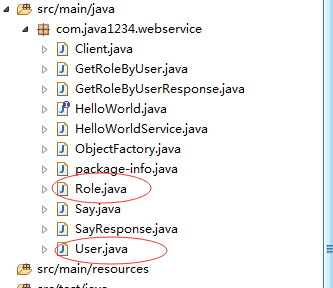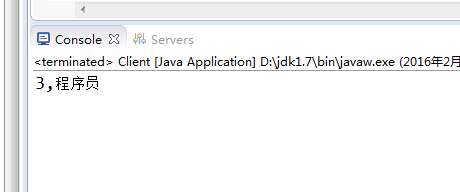
CXF处理JavaBean以及复合类型
发布时间:『 2016-02-18 10:31』 博客类别:webservice
前面讲的是处理简单类型,今天这里来讲下CXF处理JavaBean以及复合类型,比如集合;
这里实例是客户端传一个JavaBean,服务器端返回集合类型;
在原来的项目实例基础上,我们先创建一个实体类User:
package com.java1234.entity;
/**
* 用户实体类
* @author Administrator
*
*/
public class User {
private Integer id; // 编号
private String userName; // 用户名
private String password; // 密码
public Integer getId() {
return id;
}
public void setId(Integer id) {
this.id = id;
}
public String getUserName() {
return userName;
}
public void setUserName(String userName) {
this.userName = userName;
}
public String getPassword() {
return password;
}
public void setPassword(String password) {
this.password = password;
}
}再创建一个Role实体类:
package com.java1234.entity;
/**
* 角色实体
* @author Administrator
*
*/
public class Role {
private Integer id; // 编号
private String roleName; // 角色名称
public Role() {
super();
// TODO Auto-generated constructor stub
}
public Role(Integer id, String roleName) {
super();
this.id = id;
this.roleName = roleName;
}
public Integer getId() {
return id;
}
public void setId(Integer id) {
this.id = id;
}
public String getRoleName() {
return roleName;
}
public void setRoleName(String roleName) {
this.roleName = roleName;
}
}然后HelloWorld再加一个接口方法getRoleByUser,通过用户查找角色:
package com.java1234.webservice;
import java.util.List;
import javax.jws.WebService;
import com.java1234.entity.Role;
import com.java1234.entity.User;
@WebService
public interface HelloWorld {
public String say(String str);
public List<Role> getRoleByUser(User user);
}然后HelloWorld接口实现类 HelloWorldImpl写下新增的方法的具体实现,我们这里写死,模拟下即可:
package com.java1234.webservice.impl;
import java.util.ArrayList;
import java.util.List;
import javax.jws.WebService;
import com.java1234.entity.Role;
import com.java1234.entity.User;
import com.java1234.webservice.HelloWorld;
@WebService
public class HelloWorldImpl implements HelloWorld{
public String say(String str) {
return "Hello "+str;
}
public List<Role> getRoleByUser(User user) {
List<Role> roleList=new ArrayList<Role>();
// 模拟 直接写死
if(user!=null){
if(user.getUserName().equals("java1234") && user.getPassword().equals("123456")){
roleList.add(new Role(1,"技术总监"));
roleList.add(new Role(2,"架构师"));
}else if(user.getUserName().equals("jack") && user.getPassword().equals("123456")){
roleList.add(new Role(3,"程序员"));
}
return roleList;
}else{
return null;
}
}
}服务端其他地方不用动;
下面我们来处理下客户端,和前面讲的一样。我们用wsdl2java工具重新生成代码,这里就不再讲;

这里我看到,实体类,以及接口实现,代码都生成了。
我们改下Client类:
package com.java1234.webservice;
import java.util.List;
public class Client {
public static void main(String[] args) {
HelloWorldService service=new HelloWorldService();
HelloWorld helloWorld=service.getHelloWorldPort();
//System.out.println(helloWorld.say("java1234"));
User user=new User();
user.setUserName("jack");
user.setPassword("123456");
List<Role> roleList=helloWorld.getRoleByUser(user);
for(Role role:roleList){
System.out.println(role.getId()+","+role.getRoleName());
}
}
}运行截图:

完整代码:http://pan.baidu.com/s/1c1drMYO
关键字:
webservice
cxf


Java1234_小锋
(知识改变命运,技术改变世界)
- Java核心基础(145)
- QQ第三方登录(6)
- mybatis-plus(20)
- Mycat(30)
- Layui(2)
- Mysql(2)
- Docker(35)
- Dubbo(7)
- 007项目(0)
- SVN(22)
- SpringCloud(33)
- Tomcat(6)
- 支付宝接口(3)
- NodeJs(1)
- IDEA(24)
- SpringBoot(11)
- 微信扫码登录(4)
- Git(50)
- Nginx(24)
- Vue.js(50)
- jsoup(6)
- shiro(1)
- Redis(17)
- maven(6)
- 活动(20)
- hibernate(1)
- EhCache缓存框架(4)
- webservice(10)
- CAS单点登录(7)
- elasticsearch(31)
- log4j日志(8)
- IT之路(26)
- activiti(26)
- centos(25)
- java爬虫技术(14)
- 随心生活(19)
- 网站SEO(2)
- htmlunit(10)
- httpclient(7)
- 2022年12月(1)
- 2021年10月(1)
- 2021年02月(3)
- 2020年11月(3)
- 2020年10月(4)
- 2020年09月(7)
- 2020年08月(18)
- 2020年07月(21)
- 2020年06月(37)
- 2020年05月(17)
- 2020年04月(12)
- 2020年03月(10)
- 2020年02月(14)
- 2020年01月(12)
- 2019年12月(15)
- 2019年11月(27)
- 2019年10月(5)
- 2019年09月(1)
- 2019年08月(4)
- 2019年07月(28)
- 2019年06月(16)
- 2019年05月(4)
- 2019年04月(3)
- 2019年03月(2)
- 2019年02月(7)
- 2019年01月(20)
- 2018年12月(2)
- 2018年11月(5)
- 2018年10月(30)
- 2018年09月(11)
- 2018年08月(5)
- 2018年07月(9)
- 2018年06月(4)
- 2018年05月(4)
- 2018年04月(3)
- 2018年03月(7)
- 2018年02月(6)
- 2018年01月(13)
- 2017年12月(3)
- 2017年11月(10)
- 2017年10月(1)
- 2017年09月(9)
- 2017年08月(12)
- 2017年07月(19)
- 2017年06月(21)
- 2017年05月(1)
- 2017年04月(12)
- 2017年03月(13)
- 2017年02月(12)
- 2017年01月(14)
- 2016年12月(8)
- 2016年11月(25)
- 2016年10月(16)
- 2016年09月(13)
- 2016年08月(20)
- 2016年07月(12)
- 2016年06月(36)
- 2016年05月(10)
- 2016年04月(19)
- 2016年03月(14)
- 2016年02月(23)
- 2016年01月(1)
Powered by Java1234 V3.0
Copyright © 2012-2016 Java知识分享网 版权所有